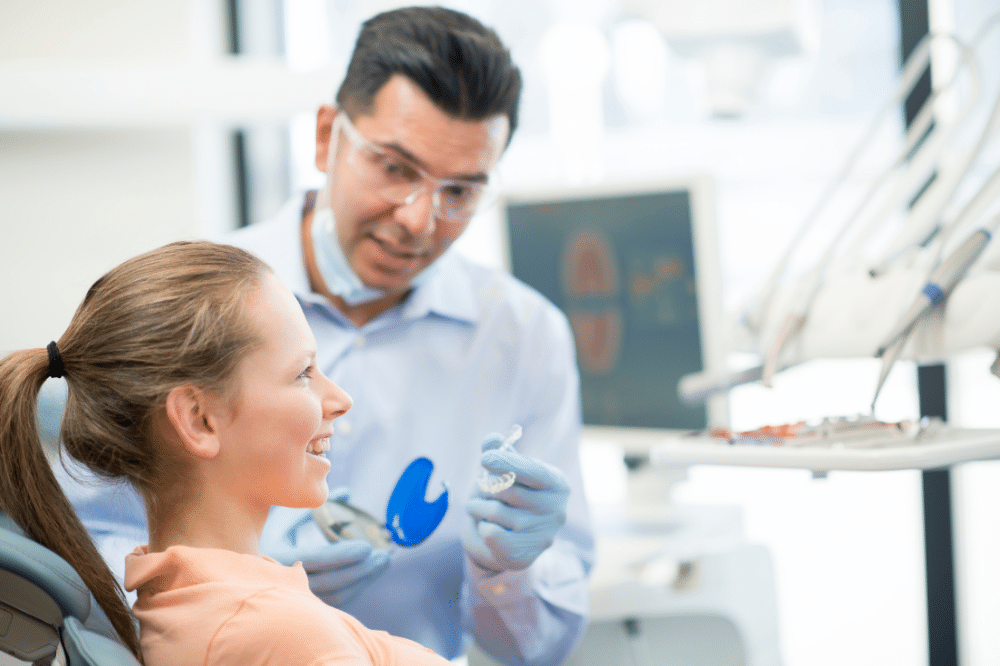Exploring which is better: Invisalign or Braces?
Are you looking to achieve that perfect, confident smile? If so, you’re not alone! Many young people are seeking orthodontic treatments to correct misaligned teeth and enhance their smiles. In this post, we’ll compare two popular options for achieving straighter teeth: Invisalign and traditional braces.
To make your decision easier, we’ll discuss the pros and cons of each treatment and help you determine which option might be better suited for your unique needs.
4 Common Advantages of Invisalign
- Aesthetics:
One of the main reasons young adults prefer Invisalign is its near-invisibility. These clear aligners are discreet, making them a perfect choice for those who feel self-conscious about wearing braces. They allow you to undergo orthodontic treatment without drawing unnecessary attention to your teeth, empowering you to smile confidently throughout the process. - Removability:
Invisalign aligners are easily removable, offering a level of convenience that traditional braces can’t match. You can take them out while eating, drinking, and performing oral hygiene routines, reducing the chances of food particles getting stuck in your teeth and making cleaning a breeze. However, it’s essential to remember that discipline is required to wear them for the recommended 20-22 hours daily for optimal results.

3. Comfort:
The absence of metal brackets and wires in Invisalign aligners translates to a more comfortable experience. Unlike traditional braces, which can occasionally cause discomfort and irritation due to wire adjustments, Invisalign’s smooth plastic aligners gently shift teeth into their desired position.
4. Treatment Duration:
Invisalign treatments typically have shorter treatment durations compared to braces, especially for minor to moderate teeth misalignments. The average treatment duration can range from 6 to 18 months, making them an appealing choice for those seeking a quicker path to a straighter smile.
4 Common Advantages of Braces
- Comprehensive Correction:
While Invisalign is an excellent option for mild to moderate orthodontic issues, traditional braces shine when it comes to addressing more complex dental problems. For individuals with severe misalignments, crowding, or significant bite issues, braces offer a reliable solution that ensures all aspects of their smile are corrected effectively. - Treatment Compliance:
Braces are fixed appliances, meaning they remain bonded to the teeth throughout the treatment period. This characteristic can be advantageous for patients who might struggle with wearing removable aligners consistently. With braces, there’s no temptation to remove them, ensuring continuous progress and optimal results. - Cost-Effectiveness:
For some patients, traditional braces may be a more cost-effective option compared to Invisalign. The overall cost can vary based on the complexity of the case, but in certain situations, braces might present a budget-friendly alternative for those on a tighter financial plan. - No Need for Replacement:
Since braces are fixed onto the teeth, there’s no need for replacement aligners throughout the treatment. This aspect might appeal to patients who prefer a more hands-off approach to their orthodontic journey.

3 Factors to Consider When Choosing either Invisalign or Braces
Now that we’ve weighed the pros and cons of Invisalign and traditional braces, how do you determine which is the better option for you?
- Lifestyle Considerations:
Consider your lifestyle and daily routines. If you prefer a treatment option that allows for discreetness and the freedom to remove the appliance occasionally, Invisalign could be your ideal choice. On the other hand, if you’re looking for a fixed treatment that requires minimal maintenance and continuous correction, traditional braces might better suit your needs. - The Severity of Orthodontic Issues:
The complexity of your dental misalignment plays a crucial role in the decision-making process. For more severe cases, braces may be the only viable option to achieve the desired results. However, for less complex issues, Invisalign can provide an efficient and visually appealing solution. - Commitment and Responsibility:
Consider your commitment level and responsibility to follow the recommended guidelines. Invisalign requires dedication to wearing the aligners as instructed, while braces necessitate regular visits for adjustments and maintenance.
Conclusion
Both Invisalign and traditional braces have their unique advantages, making them suitable for different individuals. Ultimately, the choice between Invisalign and braces should be based on your specific dental needs, preferences, and lifestyle.
At Ballard Dental Arts, our team of experienced professionals is here to help you make the best decision for a straighter, more confident smile. Schedule a consultation with us today, and let’s embark on your journey toward a healthier and more beautiful smile!
